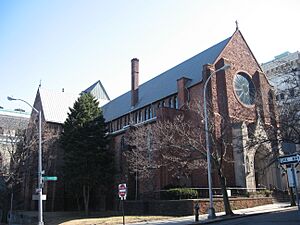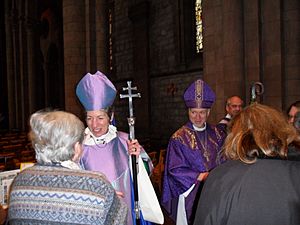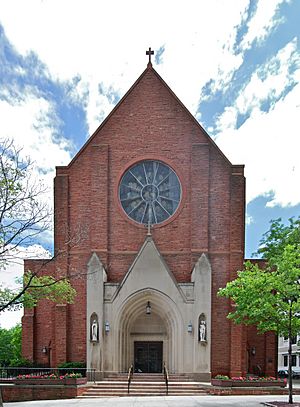Cathedral of All Saints (Albany, New York) facts for kids
Quick facts for kids The Cathedral of All Saints |
|
|---|---|
 |
|
| Location | 62 S. Swan St. Albany, NY, 12210 |
| Country | |
| Denomination | Episcopal |
| Churchmanship | Anglo-Catholic |
| Website | [1] |
| Architecture | |
| Architect(s) | Robert W. Gibson |
| Style | Neo-Gothic |
| Groundbreaking | June 3, 1884 |
| Completed | 1888 |
| Administration | |
| Diocese | Episcopal Diocese of Albany |
The Cathedral of All Saints in Albany, New York, is a beautiful and historic church. It's the main church for the Episcopal Diocese of Albany and where the Episcopal Bishop of Albany works. Built in the 1880s, it was designed by Robert W. Gibson in the Gothic style. This amazing building was added to the National Register of Historic Places in 1974.
It was the first Episcopal Cathedral church in the United States built specifically to be a cathedral. Usually, a local church was just chosen to be the bishop's church. Because of this, it's also known as the Pioneer Cathedral. The church couldn't finish the entire building and complex they planned. This was partly because the State Education Department built its headquarters on the same block. So, the cathedral will never be fully completed as first imagined.
Contents
Exploring the Cathedral Building
The Cathedral of All Saints is located at the corner of Elk and South Swan Streets in Albany. It's in a historic area, surrounded by large state government buildings. The New York State Department of Education Building is right next door. The famous state capitol building is also nearby.
Cathedral Design and Materials
The cathedral is shaped like a modified Greek cross. It has short transepts and square ends. It's mostly built from a type of stone called Potsdam sandstone. You'll also see decorative parts made from brownstone. The front of the church, facing east, is the most detailed part.
Inside, the cathedral is also made with the same East Longmeadow brownstone. The main area, called the nave, has two narrow side aisles. These are separated by huge stone columns. Six large stained glass windows let in light. More light comes from clear windows higher up, called clerestory windows.
Inside the Cathedral: Art and Details
The interior is filled with beautiful stone and wood carvings. The stained glass windows are truly special. They were designed by famous artists like Clayton and Bell from London and John LaFarge.
The floor in the nave is made of wood. But in the choir and sanctuary areas, it changes to mosaic patterns. An amazing iron and brass screen, called a rood screen, separates the choir from the nave. Some of the seats for the clergy have very detailed carvings. Behind them is a colorful reredos (a screen behind the altar) with sculptures in its niches.
A Look at the Cathedral's History
William Croswell Doane became the first bishop of the new Episcopal Diocese of Albany in 1869. For many years, his main goal was to raise money and oversee the building of the Cathedral of All Saints. This was his biggest project. Before this, no Episcopal diocese in the U.S. had built a true cathedral from scratch.
Bishop Doane wanted a cathedral like those in England. These cathedrals were not just the main church. They were also part of a larger complex with a convent (for nuns), a cloister (a covered walkway), a hospital, and a school. In 1870, he started a girls' school. Then, in 1873, the cathedral was officially started. Services were held in an old machine shop. A sisterhood (group of religious women) and a hospital were set up in 1874. Erastus Corning generously donated the land for the cathedral.
Choosing the Architect
Once the land was secured, Bishop Doane announced a competition to design the cathedral. In 1882, the winner was chosen: Robert W. Gibson. He was not well-known at the time. His design was picked over a very famous one by Henry Hobson Richardson. Richardson was already famous in Albany for his work on the state capitol and city hall. He was very disappointed his design wasn't chosen.
Gibson's design was exactly what Bishop Doane wanted. Gibson was 29 and had recently moved to the U.S. from England. He knew about the Oxford Movement, which influenced church design. He designed the building in the English Gothic style. This style used stone to make the building look old and grand right away. Gibson changed his design a bit for Albany's cold winters by making the windows narrower.
Building the Cathedral
The foundations were already in place when the cornerstone was laid in the summer of 1884. Many important people attended the ceremony. These included J.P. Morgan, Theodore Roosevelt, Leland Stanford, and Grover Cleveland. The first part of the building was carefully constructed over the next few years.
Bishop Doane wanted the building to be fully ready when it opened. This was different from European cathedrals, which were often built and opened in stages. The side walls were built to 40 feet high. A temporary roof was put on. Louis Hinton, another English immigrant, did the detailed interior stonecarving, which wasn't finished until 1891. John LaFarge designed the large round window, called a rose window, on the west wall. The London company Clayton and Bell designed the other wall windows. The carved choir stalls came from a church in Bruges, Belgium, that was torn down.
The Cathedral of All Saints was officially dedicated in 1888. The church continued to use the building as more parts were completed. In the early 1900s, the chapter house was finished. By 1909, the ceiling was at its planned height. Much of the building was paid for by a gift from Bishop Doane's friend, J. Pierpont Morgan.
Why the Cathedral is Unfinished
Over time, it became clear that Bishop Doane's big plan for a complete church complex wouldn't happen. He had bought some land on the block, but not all of it. In 1906, while he was in Europe, Andrew S. Draper bought the remaining land. Draper was the state's first Commissioner of Education. He planned to build a headquarters for his department there.
Bishop Doane had to sell his land to the state. He managed to get the state to limit the height of the new building. But this made Draper an enemy. Draper made sure each floor of his building was as tall as possible. When the state building was finished in 1913, it blocked the cathedral from view for much of the city. Both Doane and Draper died soon after.
The cathedral remains permanently unfinished. There are still foundations for two tall spires on the eastern end that Gibson had planned. These spires were never built. Most work on the cathedral since the early 1900s has been for maintenance.
In 1948, the original metal roof was replaced with asphalt shingles. In the 1950s, major renovations happened. The wooden floor in the nave was replaced with reinforced concrete. The heating system was also updated. A kitchen, multi-purpose room, and Sunday school classroom were built in the basement area.
The facade (front) of the west entrance was built in 1971. The roof shingles were replaced again in 2001. There have been no other major changes to the building since then.
Past Leaders of the Cathedral
William Croswell Doane founded the cathedral and was its first chief clergyman. Many important bishops and deans have served here. Some even became well-known national figures.
The dean emeritus (a retired leader who keeps the title) of the cathedral is The Very Rev. Marshall Vang. He served as its pastor for ten years.
William Love, a former Episcopal bishop of Albany, worked at the Cathedral of All Saints in the 1980s. He then served as its Bishop from 2007 to 2021.
Cathedral Architecture and Art
The construction of the cathedral began in 1888. It is still unfinished, though its roof was recently replaced. The altar from the old Saint Alban's chapel inside the cathedral was moved to St. Paul's church in Salem, New York.
The cathedral is a popular place for tourists. They come to see its Gothic architecture. People especially admire its colorful stained glass windows, stone carvings, and Belgian Choir stalls from the 1600s. The inside is very richly decorated. In the late 1800s, a magazine called Frank Leslie's Weekly even made a whole booklet about the cathedral for tourists.
Music at the Cathedral
The cathedral is famous for its music program. It works with the American Guild of Organists and the Royal School of Church Music in America. As an Anglo-catholic or High Church place of worship, music, choirs, and special ceremonies are very important to its services.
In the late 1800s, Bishop Doane started a boys' choir school (which no longer exists). He also created the Cathedral Choir of Men and Boys. Bishop Doane wrote the well-known Anglican hymn "Ancient of Days" while at the Cathedral of All Saints. The choir sings in many languages, including Greek, English, Latin, German, French, Italian, and Russian.
The Boys Choir sings a special evening service called compline usually on the first Friday of each month. They also sing the service of Nine Lessons and Carols every Advent season.
The cathedral is also a place for concerts, both religious and non-religious. Its amazing architecture makes it one of the "Great Acoustic Spaces for Choral Music" in the U.S. and Canada. The cathedral's pipe organ is a 1956 Aeolian-Skinner model. It was designed by G. Donald Harrison and later updated by Austin Organs.
Other Programs and Events
One old tradition brought back at the Cathedral is the election and crowning of a boy bishop. This happened during its Medieval Faire, an event that is currently on hold. This practice was common in Europe and England for nearly 300 years before the Reformation. It was linked to festivals celebrating St. Nicholas.

The synod (a church meeting) of Province II took place in Albany in May 2009. Presiding Bishop Katharine Jefferts Schori led a special service at the Cathedral of All Saints when she visited the Episcopal Diocese of Albany in 2011.
Famous Visitors and Members
Many notable people have been members or visitors at the Cathedral of All Saints. These "Cathedralites" include:
- Erastus Corning 2nd
- Martha S. Lewis
- John Pierpont Morgan
- Eleanor Roosevelt
- Franklin Delano Roosevelt
See also
- List of the Episcopal cathedrals of the United States
- List of cathedrals in the United States
- National Register of Historic Places listings in Albany, New York
Images for kids
-
Horatio Seymour memorial, nave.
-
John Adams Dix memorial, nave.
-
Hamilton Fish memorial, nave.








